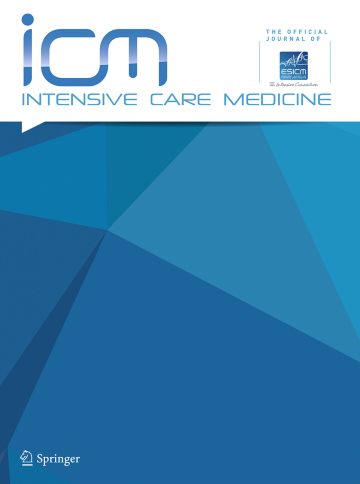ICU谵妄和疼痛的患病率和发生率:一项系统回顾和荟萃分析。
IF 21.2
1区 医学
Q1 CRITICAL CARE MEDICINE
引用次数: 0
摘要
目的:我们对先前的系统回顾和荟萃分析进行了二次分析,以检查ICU谵妄和疼痛的患病率和发生率。方法原始检索检索MEDLINE、EMBASE、CINAHL和Cochrane中央对照试验注册库(PROSPERO ID: CRD42022367715),检索时间为成立至2023年5月15日。符合本研究条件的文章来源于之前的全文综述。目前的研究包括在危重成人中进行的随机或观察性研究,这些研究报告了谵妄或疼痛的发生率或患病率。在使用随机效应荟萃分析模型进行合并之前,使用Freeman-Tukey双反正弦方法对比例数据进行转换。乔安娜·布里格斯(Joanna Briggs)的研究所患病率检查表被用于评估偏倚风险。结果共纳入517篇全文文章,213篇原创研究,226篇出版物(183285例患者)。谵妄患病率(173项研究)为35.7% (95%CI 32.4-39.0%)。最常见的谵妄亚型是低活性(16.5%,95%CI 12.1-21.4%)。合并谵妄发生率(41项研究)为28.8% (95%CI 23.2-34.8%)。11项研究的总疼痛患病率为43.5% (95%CI 28.6-58.9%)。自2013年以来,谵妄患病率下降,但发病率未下降(术前:39.9%,95%CI 34.7-45.3%;术后:32.3%,95%CI 28.2-36.5%, p = 0.02)。自2013年发布疼痛、躁动和谵妄指南以来,疼痛患病率显著下降(前:64.6%,95%CI 41.6-84.6% vs后:35.8%,95%CI 20.5-52.6%, p = 0.046)。结论自疼痛、躁动和谵妄指南发布以来,icu成人谵妄和疼痛患病率有所下降。然而,这两种情况仍然很常见,发生在多达一半的患者中。本文章由计算机程序翻译,如有差异,请以英文原文为准。
Prevalence and incidence of ICU delirium and pain: a systematic review and meta-analysis.
PURPOSE
We performed a secondary analysis of a prior systematic review and meta-analysis to examine the prevalence and incidence of ICU delirium and pain.
METHODS
The original search examined MEDLINE, EMBASE, CINAHL, and the Cochrane Central Register of Controlled trials from inception to May 15, 2023 (PROSPERO ID: CRD42022367715). Articles eligible for the current study derived from those previously reviewed at full text review. Included in the current study were randomised or observational studies among critically ill adults, that reported delirium or pain incidence or prevalence. Proportion data was transformed using the Freeman-Tukey double arcsine method prior to pooling using a random effects meta-analysis model. Joanna Briggs' Institute prevalence checklist was used for risk of bias.
RESULTS
From 517 full-text articles, 213 original studies, 226 publications (183,285 patients) were included. The pooled delirium prevalence (173 studies) was 35.7% (95%CI 32.4-39.0%). The most common delirium subtype was hypoactive (16.5%, 95%CI 12.1-21.4%). The pooled delirium incidence (41 studies) was 28.8% (95%CI 23.2-34.8%). The pooled pain prevalence (11 studies) was 43.5% (95%CI 28.6-58.9%). Delirium prevalence but not incidence decreased since 2013 (before: 39.9%, 95%CI 34.7-45.3% vs. after: 32.3%, 95%CI 28.2-36.5%, p = 0.02). Pain prevalence decreased significantly since publication of pain, agitation and delirium guidelines in 2013 (before: 64.6%, 95%CI 41.6-84.6% vs. after: 35.8%, 95%CI 20.5-52.6%, p = 0.046).
CONCLUSIONS
Delirium and pain prevalence among adults admitted to ICUs have decreased since publication of pain, agitation and delirium guidelines. However, both remain common, occurring in up to one-half of patients.
求助全文
通过发布文献求助,成功后即可免费获取论文全文。
去求助
来源期刊

Intensive Care Medicine
医学-危重病医学
CiteScore
51.50
自引率
2.80%
发文量
326
审稿时长
1 months
期刊介绍:
Intensive Care Medicine is the premier publication platform fostering the communication and exchange of cutting-edge research and ideas within the field of intensive care medicine on a comprehensive scale. Catering to professionals involved in intensive medical care, including intensivists, medical specialists, nurses, and other healthcare professionals, ICM stands as the official journal of The European Society of Intensive Care Medicine. ICM is dedicated to advancing the understanding and practice of intensive care medicine among professionals in Europe and beyond. The journal provides a robust platform for disseminating current research findings and innovative ideas in intensive care medicine. Content published in Intensive Care Medicine encompasses a wide range, including review articles, original research papers, letters, reviews, debates, and more.
 求助内容:
求助内容: 应助结果提醒方式:
应助结果提醒方式:


